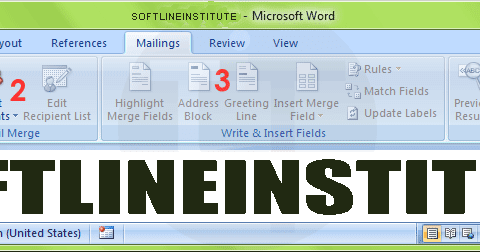

- #NO MAILINGS TAB IN WORD PROFESSIONAL#
- #NO MAILINGS TAB IN WORD ZIP#
- #NO MAILINGS TAB IN WORD WINDOWS#
Only the records meeting your criteria will be merged. If you want to set up other criteria for filtering, select And or Or from the pull-down list and repeat steps 7–9 as necessary

In the Compare to text box, type the value/text to which the information should be comparedĮXAMPLE: To finish merging the records of those who are professors, in the Compare to text box, type Dr. The Filter and Sort dialog box appears, with the Filter Records tab displayed.įrom the first Field pull-down list, select the field on which you want to base your filterĮXAMPLE: To merge only the records of a specific title, from the Field pull-down list, select Titleįrom the Comparison pull-down list, select the type of comparisonĮXAMPLE: To continue merging only the records of those who have a certain job title, from the Comparison pull-down list, select Equal to In the Refine recipient list section, click FILTER Only the records meeting the selected criteria will be merged. In the heading that you wish to filter by, click the » select the desired filter The Mail Merge Recipients dialog box appears For example, you may want to send letters only to personnel from a specific department. To close the Filter and Sort dialog box, click OKīy establishing a filter, you determine specific records to be merged and printed according to the criteria you select. To set up another sort order(s), from the Then by pull-down lists, select the appropriate options To set the order in which the records will be sorted, select Ascending or Descending The Filter and Sort dialog box appears, with the Sort Records tab displayed.įrom the Sort by pull-down list, select the appropriate option In the Refine recipient list section, click SORT HINT: Clicking the same heading again will reverse the order (i.e., ascending or descending) of the sort.įrom the Mailings tab, in the Start Mail Merge group, click START MAIL MERGE » make the appropriate selection The Mail Merge Recipients dialog box appears. Microsoft Office Word 2003 On the Tools menu, click Letters and mailings, and click Mail Merge. Microsoft Word 2002 On the Tools menu, click Letters and mailing, and click Mail Merge Wizard. In the Start Mail Merge group, click EDIT RECIPIENT LIST. To do this, follow these steps, as appropriate for the version of Word that you are running. In the Start Mail Merge group, click SELECT RECIPIENTS » make the appropriate selection

Sorting the Records: QuickSortįrom the Mailings command tab, in the Start Mail Merge group, click START MAIL MERGE » make the appropriate selection
#NO MAILINGS TAB IN WORD ZIP#
For example, you could print letters in numerical order, by zip code, or alphabetically by last name. īy selecting a sort order, you can determine the order in which your records are merged and subsequently printed. NOTE: For more information on the data document, refer to Mail Merge: An Overview. These options are selected through the Filter and Sort dialog box. For example, you can have the records sorted to print out in a specific order, or you can create a filter so you only merge records that meet specific criteria. Word's Mail Merge feature allows you to customize your merge. This article is based on legacy software. (Optional) Under the “Return address” section, change the font and position of the information.(Legacy) Microsoft Word 2007: Mail Merge: Filter and Sort Options

(Optional) Under the “Delivery address” section, change the font and position of the information. The recipients will be the people listed in your current tab in Google Sheets. Select the envelope’s size (for example, Size 10) in the “Envelope size” setting. Under the “Return address” section, enter your information, such as your name and address. Under the “Delivery address” section, enter the delivery information, such as name and destination address, as you would with any envelope. Select the blank document option (if applicable). To print an envelope with Microsoft Word, use these steps:
#NO MAILINGS TAB IN WORD WINDOWS#
This guide will teach you the steps to print an envelope using Microsoft Word on Windows 11. Whatever the reason it might be, Word from Microsoft 365, Office 2021, 2019, 2016, and older versions include the “Mailings” feature to help you print envelopes and labels easily.
#NO MAILINGS TAB IN WORD PROFESSIONAL#
Microsoft Word makes it easy to create and print an envelope without the need for complex configurations or third-party software, and in this guide, you will learn how.Īlthough the mailing system does a pretty good job recognizing virtually any handwriting to deliver a letter, sometimes, you may still want to print the information onto the envelope for a more professional look or speed up the process when sending several pieces of mail.


 0 kommentar(er)
0 kommentar(er)
